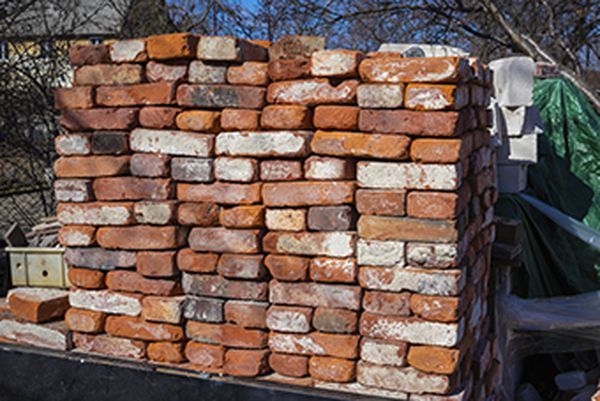Whether you're a self-builder, architect, or simply renovating your home, understanding the language of bricks can make your project smoother and more successful. At Brickhunter, we connect you with the perfect bricks for your build - and that starts with knowing what you're looking for.
In this A-Z guide, we break down the most commonly used brick terms to help you communicate clearly with suppliers, contractors, and designers.
Find your bricksA is for 'Arch Brick'
A specially shaped brick used to form arches. Typically tapered to fit the curve of the arch.
B is for 'Bond'
The pattern in which bricks are laid. Common brick bonds include Flemish, Stretcher, and English bonds. They affect the wall’s strength and appearance.
C is for 'Cavity Wall'
A double-wall construction where two brick walls are separated by a gap (cavity), improving insulation and reducing moisture penetration.
D is for 'Damp-Proof Course (DPC)'
A layer of waterproof material - usually plastic or slate - inserted into the brickwork to prevent rising damp.
E is for 'Efflorescence'
A white, powdery deposit on bricks caused by salt deposits. Usually cosmetic and can be cleaned, but may indicate moisture issues.
Understanding the language of bricks can make your project smoother and more successful
F is for 'Facing Brick'
Bricks made specifically for external use where appearance matters. Brickhunter offers a wide range of facing bricks in different colours and textures.
G is for 'Gauged Brickwork'
Gauged brickwork is the highest class of brickwork, involving accurate surveying, drawing, and precise cutting of bricks to fit the plans.
H is for 'Header'
The short face of a brick. In bonding, a header course shows the brick ends on the wall face.
I is for 'Insulating Brick'
Special bricks with thermal properties used to improve a building’s energy efficiency.
J is for 'Joint'
The mortar space between bricks. Types of joints include flush, recessed, and weather-struck, each offering different looks and performance.
K is for 'Kiln'
A furnace or oven used to fire bricks. Modern kilns ensure consistency and durability in brick production.
L is for 'Lintel'
A structural support (often steel, concrete, or timber) placed over openings like doors or windows in brick walls.
M is for 'Mortar'
The mix of sand, cement, and water used to bond bricks together. Mortar colour and texture can influence your final wall finish.
N is for 'Non-Combustible Brick'
Bricks made from clay or concrete are naturally non-combustible, making them ideal for fire-resistant construction. This is a key benefit when choosing bricks for chimneys, firewalls, or residential builds in fire-prone areas.
O is for 'Oversailing Course'
Also known as corbelling, this is a course of bricks that projects slightly beyond the face of the wall below it. Often used decoratively at the top of walls or around windows and doors to add visual interest or aid in water runoff.
P is for 'Perforated Brick'
Bricks with holes through them. They're lighter and allow mortar to bond better, often used in load-bearing applications.
Q is for 'Quoin'
A corner brick or stone that may be larger, differently coloured, or textured to provide visual contrast or strength.

R is for 'Reclaimed Brick'
Bricks salvaged from demolition and reused. They offer a weathered appearance ideal for restoration or rustic design. At Brickhunter, we help you source genuine reclaimed bricks with confidence.
S is for 'Stretcher'
The long side of the brick. In a stretcher bond, only the long faces are visible in the pattern.
T is for 'Ties'
Metal or plastic components used to tie the inner and outer leaves of a cavity wall together, ensuring structural integrity.
U is for 'Utility Brick'
A larger brick type used for faster laying and lower labour costs while maintaining strength and thermal performance.
V is for 'Veneer'
A thin layer of bricks used for decorative purposes on non-load-bearing walls or structures.
W is for 'Weathering'
The natural ageing of bricks over time, influenced by exposure to rain, sun, and pollution. Some bricks are made to simulate this effect from day one.
X is for 'X-Bond'
A rarely used but sometimes referenced custom bonding style where bricks are offset in an X pattern—used more in artistic brickwork.
Y is for 'Yield'
The number of usable bricks from a production batch. Yield can be affected by breakage, warping, or imperfections.
Z is for 'Zero Expansion'
A term relating to how much a brick expands or contracts with temperature changes. Low or zero expansion bricks are ideal for precision work or extreme climates.
Ready to Get Started?
Understanding brick terminology is more than just technical know-how - it’s a way to take control of your build.
Whether you're sourcing bespoke bricks, looking for eco-friendly options, or restoring a heritage property, Brickhunter is here to help.
Browse our full range of bricks or speak to our expert team today to find the perfect match for your next project. Start your brick search now...





